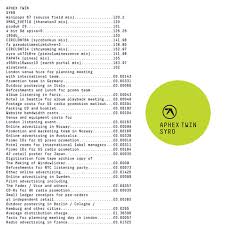Cast your mind back to 2001. It was the year in which Richard D. James last released a full length album under the moniker of Aphex Twin. The Strokes had just brought out their debut album, Britney Spears was in her pre-meltdown pomp, people listened to Nu-Metal and MTV still played music videos (even the odd Aphex Twin cut). Flash forward thirteen years and it goes without saying that ‘Syro’, his first album since then, is released into a very different musical landscape. Thankfully though, James has never concerned himself too much with musical landscapes or boundaries, preferring to break rather than to adhere to both. It’s for this reason that, even after his extended hiatus, ‘Syro’ slots perfectly into 2014.
Given his penchant for shape shifting and bouncing between musical styles, it would be logical to assume ‘Syro’ is a complete departure from previous works. This isn’t quite the case though. From the very outset this is unmistakably an Aphex Twin album – in fact it feels like it begins where ‘Drunqs’ left off. With the gap in time between albums surpassing a decade this should make ‘Syro’ sound horribly outdated. Fortunately James has always been a musical sponge and while he’s retained much of the core sound of ‘Drunqs’, he’s also absorbed just about everything good that’s happened in electro music over the past decade into his repertoire. The results don’t so much sound modern as they sound like the future.
The reason this album feels so cutting edge is down to the fact that it’s far less jarring than his previous works. Everything is much smoother and cleaner than previous releases and in 180db_{130} we get, possibly, the most accessible track he’s ever released. It would still be a big stretch to call it commercial, David Guetta certainly won’t be losing any sleep over it, but unlike 99% of his back catalogue, this wouldn’t sound too out of place on FM radio. Sandwiched in between acid tinged 4 bit 9d api+e+6[126.26] and the frankly deranged CIRCLONT6A [141.98], the trio make for the album’s best run of songs.
While this is his most assessable work to date it’s still by no means straightforward. Over 138 pieces of equipment were used in the making of the album’s twelve tracks. In the hands of a lesser artist this kitchen sink approach to production would sound like a mess, mindless noodling at its worst. In the hands of James it all sounds essential. His arrangements are so precise they are almost flawless. There’s so many moments that stand out; the exquisite synths that close out the produk 29 [101]; the rolling percussion on XMAS_EVET10 [120] (thanaton3 mix); and the twisted, indecipherable vocals on minipops 67 (source field mix). Those three examples don’t even touch the surface, there’s so many moments of brilliance on this album that its takes multiple listens to take most of it in.
He may not be pushing music to its outer limits as he has done on previous releases but this album is still in the upper echelons of Richard D. James extensive works. For the few fans of electro music that haven’t heard this record purchase it now. For those who want to discover what all the fuss is about one of most innovative musicians of all time this album offers the perfect introduction. Either way, this is an essential listen.

